Reply To:
Name - Reply Comment
 We view that Sri Lanka is at a critical juncture whether it can remain as a potentially growing country with the trust of international community, or otherwise.
We view that Sri Lanka is at a critical juncture whether it can remain as a potentially growing country with the trust of international community, or otherwise.
Sri Lanka’s foreign exchange reserves are at dangerously low levels (US$ 1.6 billion or less than one month of imports), especially given the US$ 6.9 billion in debt service payments coming due in 2022.
The acute shortage of foreign exchange is due to the COVID-19 pandemic, causing a sharp decline in tourism earnings, and reduced overseas worker’s remittances. It has also disrupted Sri Lanka’s own efforts to improve the debt sustainability.
 The International Sovereign Bond payment (US$ 500 million) on 18th January 2022 was made possible only through the very timely SWAP (US$ 400 million) from the Reserve Bank of India and the deferral of a payment (US$ 500 million) to India under the Asian Clearing Union (ACU).
The International Sovereign Bond payment (US$ 500 million) on 18th January 2022 was made possible only through the very timely SWAP (US$ 400 million) from the Reserve Bank of India and the deferral of a payment (US$ 500 million) to India under the Asian Clearing Union (ACU).
Both of these are short-term interventions. The former is a three-month facility, which can be renewed twice (i. e. nine months) before the requirement of at least a staff-level agreement with the IMF.
The ACU payment has been deferred for two months (now due in March 2022). Without this much needed support from India, Sri Lanka would have defaulted on the recent ISB payment and triggered an economic and humanitarian crisis.
Meanwhile, the low level of reserves is leading to shortages of imports that are causing, on top of the COVID-19 pandemic, additional hardship to everyday Sri Lankans. People stand in long lines for cooking gas; powdered milk is unavailable; power cuts are frequent; medicines are becoming difficult to find, while the cost of staple food items are sky rocketing.
The real problem is that Sri Lanka’s external debt is unsustainable. The revenue that the government will earn, even under the most optimistic scenarios, will be insufficient to cover public expenditures and meet debt service payments over the coming years.
Known external debt repayments over the next five years amount to US$ 26 billion, or about US$ 5 billion a year, which is over 80 percent of government revenue in 2020. Market participants recognize this. When in 2019 Sri Lanka cut taxes and experienced a drop in tax revenues, the three major rating agencies downgraded the country to C, which is near-default level. In January of this year, when the Governor of the Central Bank announced that Sri Lanka had secured the funds to meet the US$ 500 million bond payment, S&P downgraded Sri Lanka further.
In this setting, Sri Lanka should avoid a hard default at all costs. Such abrupt actions, when the country stops paying its creditors, lead to a collapse of GDP, hyperinflation, and severe depreciation of the currency. At the same time, Sri Lanka should not continue meeting its debt-service payments in full—and starving its people of essential imports--when everybody, including market participants, knows that the country cannot sustain this strategy.
The only choice is for Sri Lanka to undertake a managed debt restructuring, whereby the country reaches an agreement with its creditors to reduce the overall debt to a sustainable level. The process begins with the appointment of financial and legal advisors. The restructuring is greatly facilitated by approaching the IMF for support on two items. First, the IMF can undertake the analysis to determine the sustainable level of debt. This analysis serves as an anchor for the negotiations with the creditors. Secondly, if Sri Lanka has a program with the IMF, that increases investors’ confidence that the new debt level is sustainable. It could also lead to additional resources from the IMF, the World Bank, Asian Development Bank and other partners.
These negotiations are likely to take about six months. In the meantime, there is urgent need for bridging finance to meet the severe shortfall in US$ liquidity over this period. Failure to mobilise this bridging finance will lead to severe shortages of food, fuel and pharmaceuticals, causing a great deal of hardship and possibly social unrest, pushing individuals to leave the country through legal and illegal channels. The table sets out the minimum foreign exchange needs to finance debt service payments and essential imports for 2022. With the initiation of debt restructuring negotiations, the debt servicing would be suspended, so the requirements would be US$ 3.5 billion per semester. There is a possibility that Sri Lanka will receive a US$ 1 billion SWAP from a national government and an additional $0.5 billion of usable reserves from a private entity but these have not been confirmed.
In the absence of these inflows, there is a financing gap of US$ 3.5 billion over the next six months, which should be filled to avert a humanitarian disaster. While the above is admittedly an estimate, the governments of Sri Lanka, Japan and India could agree on a figure that can be reviewed on a quarterly basis.
The government of Sri Lanka, along with Japan and India as major development partners, can collaborate on a program of debt restructuring and bridge financing in the following way:
1.The Government of Sri Lanka initiate a managed debt restructuring by appointing the financial and legal advisors. The government approaches the IMF for assistance with the debt restructuring.
2. Following the initiation of the debt restructuring, the government of Sri Lanka requests the Governments of Japan and India to provide impetus to the restructuring exercise and develop programmes for providing bridge financing to Sri Lanka during the negotiations. The bridging finance could take the form of humanitarian assistance through lines of credit to support essential imports (see Table). These will be one-time financial transfers, which will end with the conclusion of the debt restructuring negotiations.
3. Japan and India will encourage the international community to apply to Sri Lanka’s case the principles of G-20 Common Framework as well as the Debt Service Suspension Initiative (DSSI) for lower income countries.
This collaboration would give the Government of Sri Lanka the assurance that, when they embark on a debt restructuring exercise, the immediate needs for essential imports will be met. It will give the Governments of Japan and India the assurance that the bridge financing will be needed during the transition only, as Sri Lanka, just like other countries that have undergone the same process, will likely be able to meet its needs going forward through additional financing and lower debt service payments.
(The Study Group for Tripartite Cooperation led by by Pathfinder Foundaiton comprises of Amb. Nobuhito Hobo, Professor, National Graduate Institute for Policy Studies (GRIPS) & Executive Adviser, GRIPS – ALLIANCE – Japan; Prof. Shinji Asanuma, Former Professor, School of International and Public Policy, Hitotsubashi University – Japan; Prof. Hirohisa Kohama, Professor Emeritus of Economics, Faculty of International Relations, University of Shizuoka – Japan; Amb. Dr. Mohan Kumar, Chairman, Research and Information System for Developing Countries (RIS) – India; Bernard Goonetilleke, Chairman, Pathfinder Foundation – Sri Lanka; Dr. IndrajitCoomaraswamy, Distinguished Fellow, The Pathfinder Foundation – Sri Lanka; and Dr. Shanta Devarajan, Professor, The Practice of International Development at Georgetown University’s Edmund A. Walsh School of Foreign Service – USA)